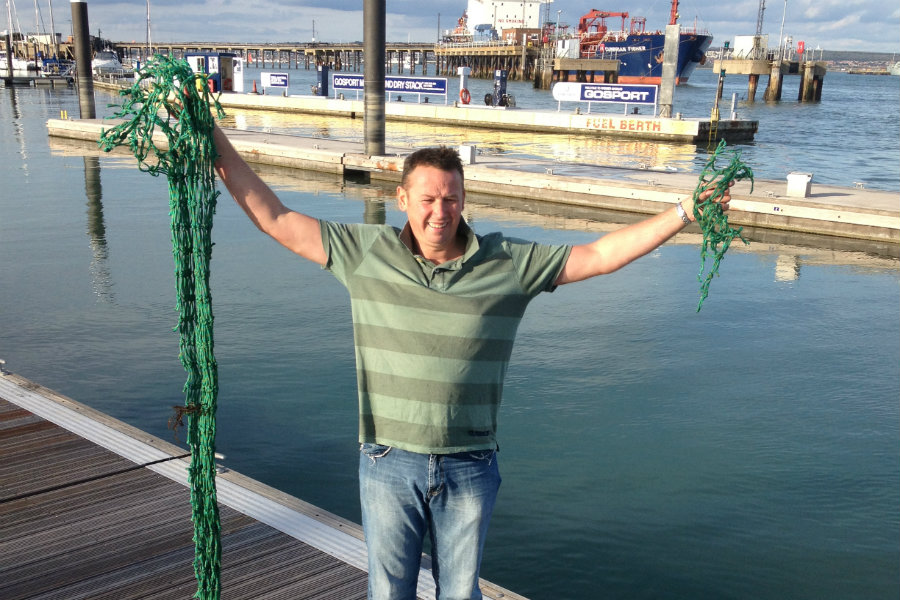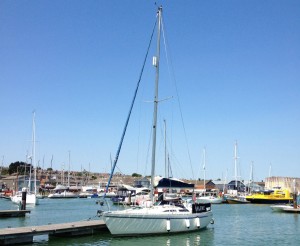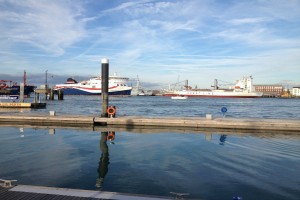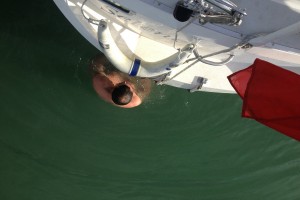 This section of my website is dedicated to life aboard our sailboat. The issue I have, however, is that I don’t live on it yet. Hehehehe. However, let me tell you a tale of engine failure that I experience on our previous sailboat…
This section of my website is dedicated to life aboard our sailboat. The issue I have, however, is that I don’t live on it yet. Hehehehe. However, let me tell you a tale of engine failure that I experience on our previous sailboat…
Surviving engine failure on our 346 Moody Yacht while exiting one of the busiest waterways in England!

Around 10am on a lazy Sunday morning I noticed that not only was it sunny out, but it was also warm. Very warm for an October day in the UK. PING. My thoughts quickly raced and I yelled out to hubby, ‘Why don’t we go out for a sail in Selene today – perhaps a nice journey over to Cowes (Isle of White) for the night?!’
His response was an immediate ‘yes’ so within a half hour the car was packed, our three year old daughter, Sienna, was snug in her car seat and we were on our way.
After a quick stop at the store for food, a couple large coffees and a 2 hour drive, we were on the boat getting ready to set sail. For the first time in 2 years I experienced leaving our mooring under ‘free sail.’ Our boat is berthed at a marina in a place called Port Solent – it operates under a lock system. Usually you have to enter the lock and wait until the water levels are correct and then you can leave.
The day started out with smooth sailing – too smooth!
Today – we simply sailed right through. The sun was shining, I was in a T-shirt in October and the wind was mild. What a perfect day.

As we progressed towards towards the Solent we watched many boats returning home. There were some visiting naval ships, the usual UK navy ships along with the Gosport to Portsmouth ferry and the Isle of White Ferries. Just as we were passing a large industrial ship and coming up to Gosport Marina, one of the busiest areas of the harbour, we heard a BING and then the engine suddenly cut off. (We were located where the sailboat in the picture is)
Engine failure – an instant shot of adrenalin surged through my body
My husband, Simon, quickly tried to restart the engine. It would start but once engaged the engine would immediately cut out.
I quickly threw all our cushions and Sienna’s toys down into the centre of the boat and asked Sienna to go into the aft cabin. She didn’t realise the severity of the situation so I explained, ‘we’re having an emergency – I need you to go down below.’ Sienna reluctantly said, ‘Okay’ and climbed down the stairs. Not bad for a 3 year old.
What do we do? What do we do? What do we do?
Simon then asked me to notify the coast guard by radioing a PAN-PAN. Surveying the situation, and knowing that there were only two of us, we decided we didn’t have enough time. Although we had the main sail up it was luffing and we were drifting towards various dangers. Thinking quickly, we yelled over to an oncoming 36′ yacht explaining that our engine had stopped.
The oncoming yacht quickly circled around us as I fastened warps and fenders to the starboard side of the boat. With my heart pounding, body shaking and nerves heightened, we tied ourselves onto our rescue boat.
No engine, drifting towards a tanker with 50 canoes headed straight for us – could it get worse?
Oblivious to everything around us, Simon and I looked up and noticed we were heading straight on to a school of 50 canoes! Simon yelled out, ‘We have no engine!’ and then one of the canoers yelled back, ‘Neither do we!’ Simon then yelled back, ‘we have no paddles either!’ Within a millisecond the canoers all diverted around us.
We then dropped the sail. Luckily we were near a huge stationary tanker and there was very little wind in our mainsail. It dropped easily.
Our rescuer’s aimed for a nearby fuel dock and luckily there were a couple people on the dock to take our port-side warps and secure Selene for us. We thanked the three men who saved us and they were on there way.
What cause our engine to suddenly cut out when put into gear?
Soon after we calmed our nerves a bit the incredibly kind Marina attendent towed us to a more secure location. While towing us he noticed a rope trailing below the boat. Perhaps we ran over a floating rope and our rope cutter (affixed to the prop) didn’t work?
Once out of site, Simon, jumped into the water to have a look at the prop. Luckily it was a warm-ish day and thankfully he offered to do the dirty work (relieving me from the duty)! He used the aft warp to hold onto as the tide was racing out quickly.
Simon jumped into the cold English waters to survey the prop
After surveying the prop he returned explaining that a huge fishing net was wrapped around the prop. I rummaged through all the stuff we’ve purchased ‘in case of an emergency’ yet never used and found our emergency cutting knife. I tied a rope around the handle so that Simon could slip it over his wrist.
After a half hour Simon loosened the net substantially but was struggling to see the full picture without a mask. While taking a break hanging off the aft ladder he started to talk about defeat.

Time to accept defeat?
Kim – I don’t think I can get this done without a mask. I just can’t see. And to make matters worse, the tide is getting stronger.
No more than 30 seconds later, a couple who were walking towards their beautiful power boat yelled over, ‘Do you need a mask?’ Talk about fate. Within 10 minutes of using the mask, Simon removed the fishing net.
Lessons learned through our engine failure
We learned quite a few lessons during our emergency situation.
1. We discovered that although we’ve been RYA trained on how to handle an emergency, sometimes you have to think on your feet and do what feels right rather than what you’ve been taught. Rather than call the coast guard, we yelled out for help and I think that was the best thing we could have done.
2. Both Simon and I realised that we were able to survive an emergency. We didn’t panic, yell or freak out. We kept surveying the situation and took actions that would protect us, others and the boat. The way in which we survived the emergency increased our confidence massively. You never know how you’re going to handle an emergency until it happens – do you?
3. We were overwhelmed by the kindness offered by everyone around us. I’ve had various emergencies in the past and I’ve rescued many boaters too. No matter what the situation, everyone seems to drop everything and ensure others are assisted. Several amateur boaters (me included) can easily get nervous about getting out and enjoying the seas, but knowing that people are eager to help, again, helps to increase confidence.
We eventually made it to our intended destination and WOW did I enjoy my wine that evening
In the end, we started our engine and she sounded fine. Rather than return to Port Solent we got back on our horse and carried on. And our efforts were rewarded – on our approach to Cowes we enjoyed a magnificent sunset.
I don’t ever want to welcome an emergency but having gone through this situation I definitely feel more comfortable with expanding my sailing experiences and adventures.
The first thing to do in this sort of emergency is to drop your anchor. Then you have all the time in the world to sort out the problem. Last season we had a fire onboard and needed to shut down all systems right at the harbor entrance. I immediately dropped the anchor, found the source of the smoke, then set about figuring out how to get back in the harbor without power. Oh yeah… I’m on a sailboat. Deployed the sails, hoisted the anchor manually, and sailed back in. Dropping your anchor slows everything down so you can reason your way out of the mess.